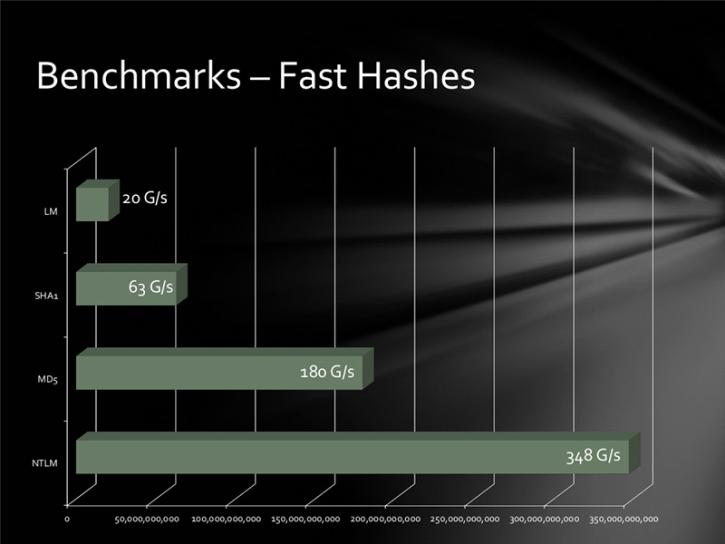A presentation at the Passwords^12 Conference in Oslo, Norway, has moved the goalposts, again. Speaking on Monday, researcher Jeremi Gosney (a.k.a epixoip) demonstrated a rig that leveraged the Open Computing Language (OpenCL) framework and a technology known as Virtual OpenCL (VCL) to run the HashCat password cracking program across a cluster of five, 4U servers equipped with 25 AMD Radeon GPUs and communicating at 10 Gbps over Infiniband switched fabric.
Gosney's system elevates password cracking to the next level, and effectively renders even the strongest passwords protected with weaker encryption algorithms, like Microsoft's LM and NTLM, obsolete.
In a test, the researcher's system was able to churn through 348 billion NTLM password hashes per second. That renders even the most secure password vulnerable to compute-intensive brute force and wordlist (or dictionary) attacks. A 14 character Windows XP password hashed using LM, for example, would fall in just six minutes, said Per Thorsheim, organizer of the Passwords^12 Conference
[Note of clarification from Jeremi: "LM Is what is used on Win XP, and LM converts all lowercase chars to uppercase, is at most 14 chars long, and splits the password into two 7 char strings before hashing -- so we only have to crack 69^7 combinations at most for LM. At 20 G/s we can get through that in about 6 minutes. With 348 billion NTLM per second, this means we could rip through any 8 character password (95^8 combinations) in 5.5 hours." ]
“Passwords on Windows XP? Not good enough anymore,” Thorsheim said.
Tools like Gosney’s GPU cluster aren’t suited for an “online” attack scenario against a live system. Rather, they’re used in “offline” attacks against collections of leaked or stolen passwords that were stored in encrypted form, Thorsheim said. In that situation, attackers aren’t limited to a set number of password attempts – hardware and software limitations are all that matter.
(slides available here - PDF)
The clustered GPUs clocked impressive speeds against more sturdy hashing algorithms as well, including MD5 (180 billion attempts per second, 63 billion/second for SHA1 and 20 billion/second for passwords hashed using the LM algorithm. So called “slow hash” algorithms fared better. The bcrypt (05) and sha512crypt permitted 71,000 and 364,000 per second, respectively.
Published benchmarks against common hashing algorithms using the 25 GPU HPC cluster
In an IRC chat with Security Ledger, Gosney said he has been working on CPU clustering for about five years and GPU clustering for the last four years.
“Then we just started trying to build the biggest GPU rigs we could, packing as many GPUs into a single server as possible so that we wouldn’t have to deal with clustering or distributing load,” Gosney wrote..
Password Cracking 25 GPU Monster Devours Passwords Real Fast



